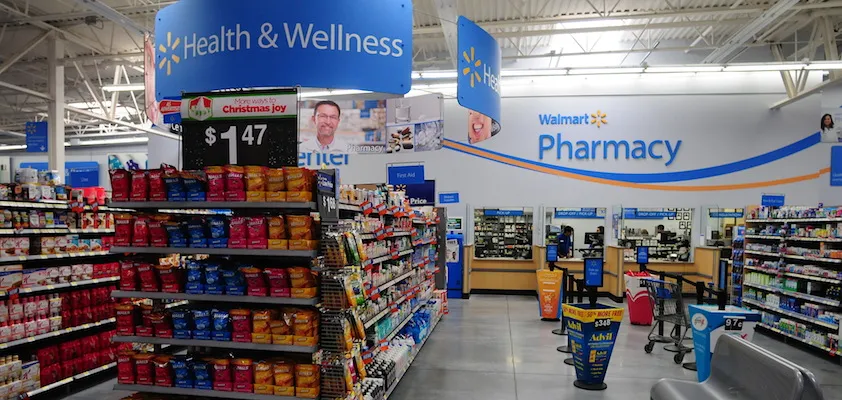BENTONVILLE, Ark. — Walmart has had a long history of making health care more accessible and affordable. From the launch of $4 generics in 2006 to the recent introduction of Walmart Care Clinics, which promise to have the same kind of impact on pricing in that sector as the earlier program did in pharmacy, the discounter has demonstrated its commitment to using its unmatched capabilities and scale to help customers maintain their well-being, and do so at a reasonable cost.
‘’Walmart is the only retailer in the United States that operates its own pharmacies, vision centers and Care Clinics, plus provides a comprehensive assortment of preventive and wellness products in categories ranging from grocery to electronics, sporting goods, home apparel and consumables — both in stores and online,” says Michelle Gloeckler, executive vice president of consumables and health and wellness at Walmart U.S., who adds that over the course of the past year the retailer has introduced thousands of wellness products, and made plans to expand in such notable areas as specialty medications, durable medical equipment and active nutrition.
For carving out that unique place in health and wellness, one that people sometimes lose sight of amidst the scope of the company’s overall business, Chain Drug Review has named Walmart Pharmacy Innovator of the Year for 2015.
Walmart’s ability to connect with consumers, 140 million of whom shop its stores every week, was dramatically illustrated in October when the company staged “America’s Biggest Health Fair.” Held at some 4,400 stores across the nation, the event included free blood glucose, hypertension and vision testing, as well as timely information about coverage options under the Affordable Care Act and Medicare Part D. In just four hours, more than 280,000 screenings were provided, along with over 50,000 immunizations for flu and other conditions.
Michelle Gloeckler
Impressive as those numbers are, they only begin to tell the story. The event produced numerous instances where people discovered they had serious health conditions. One woman who came into a store for a hypertension screening found out that she had very high blood pressure and was in danger of having a heart attack. She was immediately hospitalized. Another Walmart customer received test results that pointed to a problem that was subsequently diagnosed as a curable form of cancer. If not for the screening, the disease may have progressed to the point where it could no longer be treated.
“Our focus is on preventive care and supporting overall well-being,” notes Gloeckler. She says that innovations such as the health fair and Care Clinics have major significance for people dealing with the shortage of primary care physicians or, at the least, long lead times for any sort of appointment. Those people include Walmart’s 1.4 million U.S. associates.
Another example of the company’s innovation in retail pharmacy services is its collaboration with Directhealth.com to help customers identify health insurance needs, compare coverage options and enroll in the plan that’s right for them. The open enrollment program for customers, Healthcare Begins Here, is being offered through January 31 in more than 2,400 stores. It’s also available online and via phone. New this year, Directhealth.com is working with Jackson Hewitt to staff licensed insurance agents in about 250 stores. The agents are helping customers navigate more than 70,000 health exchange plans as well as helping those over 65 enroll in Medicare.
And the discounter has revamped the health and wellness page on Walmart.com to help customers manage their health wherever they are. The site presents information on boosting immunity and living well with diabetes while highlighting products across many categories. “Millions of our customers are using the Walmart mobile app to do things like fill prescriptions, and we think that they’ll be excited about the new additions to our site,” Gloeckler comments.
Consumer behavior is changing, she adds, with people taking an active role in their personal health, conducting research online and overall watching for ways to live better. However, there are some actions they cannot undertake on their own, like getting immunizations, and others they cannot do without the necessary devices, like glucose and blood pressure screenings. The health fair — for which no appointments were necessary — removed those hurdles. It also gave people a chance to hear from an expert about health insurance without navigating multiple screens on a website or being put on hold after making a call to an exchange.
As the nation’s largest grocer, Walmart also makes healthful food accessible and affordable. In 2014 the chain saved customers more than $1 billion on fresh fruits and vegetables. It also beat by a full year its deadline of opening at least 300 stores in food deserts — areas underserved by supermarkets. And it has made significant progress toward its goals of reducing sodium, sugar and trans fats in its grocery items, in both its store brands, including Great Value, and national brands. Through 2014, the company had reduced added sodium in the food products sold in its stores by 16% and reduced added sugars by more than 10%, and now less than 6% of its products contain industrially produced trans fats.
On the merchandising front, Gloeckler notes that the chain is moving many of its protein bars, including Special K, Luna and Clif bars from the over-the-counter drug department into the more mainstream grocery aisles. These aisles have more holding capacity, deeper shelves and, at times, more traffic. “So we’re all watching what the customer behavior is,” she says. “They’re making healthier choices, looking at labels, reading protein content and maybe not necessarily shopping for those in the O-T-C area where we’re currently offering them.”
The move allows Walmart to expand its protein bar assortment, carry more SKUs, add facings and improve its in-stock position, she says. “And we’re probably a little bit ahead of the customer here, but we certainly think that that’s where customers are going, and we’re in a position to offer them healthy alternatives as they’re doing their several shopping trips a week up and down our grocery aisles.”
Also, a new Walmart Supercenter in Royse City, Texas, features a Care Clinic, pharmacy and vision center laid out contiguously up front. And those departments are complemented with H&BA categories including O-T-Cs and cosmetics. “It’s got a new look and feel and a whole host of other things that we believe are right for the future,” Gloeckler says.
Summing up Walmart’s approach to health care, she says, “There is one thing that we cannot put a price on and that’s the health of our customers. We realize at Walmart we play an important role in making health care available to millions and helping millions put healthy meals on the table. This is a responsibility we take seriously. From managing diabetes to running your first 5K and to simply putting healthy foods on the table or having healthy foods for your on-the-go lifestyle, we’re equipping our customers with solutions for total health management, which stands for nutrition, fitness, preventative care and treatment.”







